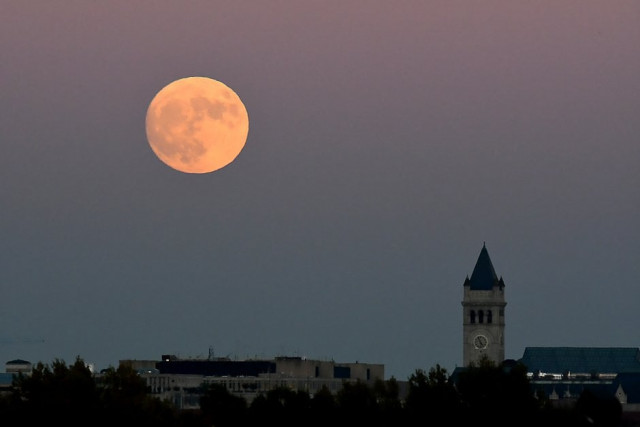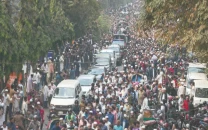How to take the best smartphone picture of supermoon
Find out here

The moon rises behind the Espa a building in Madrid, on November 13, 2016, on the eve of a "supermoon". PHOTO: AFP
However, it might end up looking like a discarded chewing gum in your Instagram feed.
The supermoon may not look too much impressive than your average moon, but there are likely to be good opportunities for photography at 6:52pm in Pakistan when it will be the biggest.
If you do not have a fancy camera, here are some tips for capturing its glory with only your smartphone, according to Mashable:
Here's when you can see the biggest supermoon since 1948
1. Find a vantage point
Remember to scope your spot in advance. The shot will be most impressive if it shows a sense of scale. Try capturing the moon when it's close to the horizon, so the image includes a foreground. As it rises over a city or a local landmark, for example, or over headlands if you're near the coast.
Nasa's senior photographer Bill Ingalls recommends being in an urban area where there's more light. "It's all relative. For me, it would be maddening and frustrating — yet it may be a good challenge, actually," he told Nasa. "You're not going to get a giant moon in your shot, but you can do something more panoramic, including some foreground that's interesting."
2. Get your gear
According to smartphone photography specialist Leigh Stark, a smartphone with some extra camera oomph can help. "iPhone 7 Plus owners should get the most fun out of this simply due to the zoom afforded by that extra camera, as it will let you get closer optically," he told Mashable in an email. "That's what we want, by the way, since digital zoom — your regular pinch to zoom — blows up pixels.
"The iPhone 7 Plus will let you zoom in with an optical zoom, while the iPhone 7 works with digital zoom." It's also worth using a tripod to eliminate wobble for the crispest photo possible. Failing that, prop it up against a book or post.
Also, don't forget you could use a telescope. "You may be able to find a mount that lets you connect your iPhone to the telescope for the best close-ups of the moon," Stark added. "You shouldn't need one during a supermoon unless you desperately want to see what the craters look like up close!"
3. Get the right apps
Stark recommends budding phone photographers download the free iOS and Android Adobe Lightroom app, which comes with an in-app camera. It's most important feature? RAW support. "If you're not familiar with RAW, think of it as a digital negative, capturing more information and detail than a standard JPEG, and allowing you to extract this later on," he explained. In the app, click on the camera where two options should be offered — "JPG" or "DNG."
Choose DNG. "DNG is Adobe's RAW format, also known as Digital Negative, and when you capture images in this format, you'll be able to get more detail out of them later on," Stark explained. "Or to put it more simply, think of RAW and DNG as the same format professional photographers capture in." By capturing in RAW format, you could blend images later to get the best overall shot.
4. Hone your focus technique
If you're only using a smartphone camera, make sure you touch the moon to focus and also adjust for brightness. "If you're trying to get the moon in a scene, make sure to focus on where you want the light to be," Stark said.
"For instance, if you're up high enough to capture the moon over your capital city, hanging in the skyline, focusing on the moon could provide enough light for the buildings, while focusing on the darker buildings and exposing for this could turn the super bright light into a sun found at night."



















COMMENTS
Comments are moderated and generally will be posted if they are on-topic and not abusive.
For more information, please see our Comments FAQ